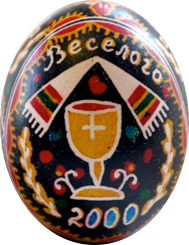Willow Motifs

Pussy Willow Sunday

In Ukraine the last Sunday before Easter (Palm Sunday) is called Willow Sunday (Verbna nedilia). On this day pussy willow branches are blessed in the church, instead of palms, as in the west. People tap one another with these blessed branches, repeating the wish:
Будь великим, як Верба,
А здоровим, як Вода,
А багатим, як Земля.
Be as tall as the willow,
as healthy as the water,
and as rich as the earth.
Or they may chant:
Не я б’ю -- верба б’є
За тиждень Великдень
Недалечко червоне яєчко!
The willow hits you, not I
In a week it will be Velykden
and soon you’ll have a red egg!
The origins of this custom are ancient, and probably precede the acceptance of christianity in Ukraine. It is said that this tapping transferred living energy from the willow plant (which was a goddess totem) to the person being tapped. Children, particularly, would be tapped, so they would grow big, strong and healthy.
The blessed willow branches were then taken home. Some of the blessed pussy willow branches were placed above the holy pictures in the home, to protect the household from evil spirits. These branches would replace the branches that had been placed the previous year. The branches which were taken down were carefully burned; a few would be used to light the stove to bake this year’s pasky.
This is an Easter card designed by Olena Kulchytska which depicts the blessing of the pussy willow branches:
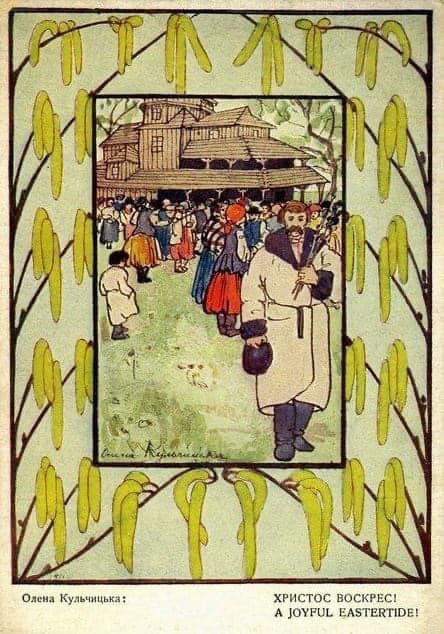
Some of the branches were planted by the father or oldest son. If they took root, it meant a marriage for the daughter or son of the family. Often they would be planted near the family’s well, to keep evils spirits away from it, and to make the water healthy and good tasting.
Blessed branches were used to drive the cattle to pasture for the first time on St. George’s Day, and then the father or eldest son would lightly tap the cattle with them to ensure good health and fecundity.
Branches would be used to ward off storms, and thrown into fires to help put them out. A branch or two would be placed in the coffin with the deceased, to protect them from demons.
Pussy willow branches are sometimes depicted on pysanky, where they can be depicted with botanical accuracy or in a stylized form.

Pussy willow branches are not a common finding on older pysanky–perusing the pages of Elyjiw or Binyashevsky will give very few examples. This is the only one I could find in the older pysanka literature: «Бечкова» from Berehomet, povit Storozhynets, Bukovyna.

Pussy willow branches have become quite frequent motifs on Pokuttian folk pysanky in recent years. They are rarely the central motif, but are included in compositions as a decorative element, perhaps replacing pine branches or other sorts of branching motifs.
Hutsul and Pokuttian pysankarky still produce many thousands of folk pysanky each spring for Easter markets in Kosiv, Zabolotiv and other towns. They write with their traditional pysachky on full eggs, and use ancient motifs passed along through generations. They are not unaffected by fashion–motifs and designs come and go over the years. In the past decade pussy willow branches have made a resurgence, and Easter baskets, candles and Christian crosses have been seen much more often. Below is a photo of one pysankarka’s offerings at the 2016 Zabolotiv Easter market.

The least common type of pussy willow pysanka is one where the branches are the main motif. This pysanka from the Horodenka region is of that sort:

The more traditional sort of pussy willow pysanky are those where branches are used to frame another motif–a church, a cross, a basket. These are a few of those:



Next we have traditional designs into which willow branches appear to have been intercalated. They do not really add to the design, but they don’t particularly detract. They’re just.......there. In some cases, like the pysanky on the right, the willow branches have replaced the wings of the berehynia.



Third we have examples of designs in which the pussy willow branches are used to outline or as dividing lines. These are not as common, but in these cases plain lines have been converted to willow branches. On the left the pussy willow creates the edges of the dividing band. On the right the pussy willow is the dividing line. On the pysanka in the middle, the willow branches have replaced the outline of the central motif, the cross.



And lastly we have the pussy willow used as a decorative element in and of itself. It may be small sprigs added here and there for an attractive effect, like a grace note in music:
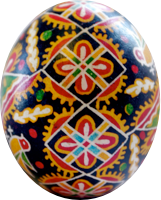

Or it can be large branches of pussy willow, possibly replacing earlier decorative elements like pine branches or curls:
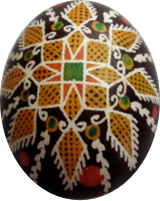
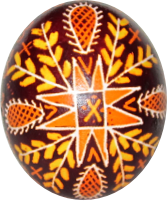
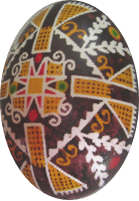
Or it can even be branches of pussy willow place inside of other elements, like these crosses:

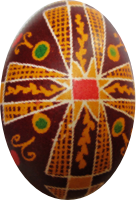
Below are more examples of pysanky with pussy willow motifs. They were collected by Vira Manko at Easter markets in Zabolotiv and other towns in Ivano-Frankivsk oblast. The photos vary in quality because they were taken in field conditions, not in a studio. But you can make out the designs and their elements. Please copy the designs and thus preserve them.
